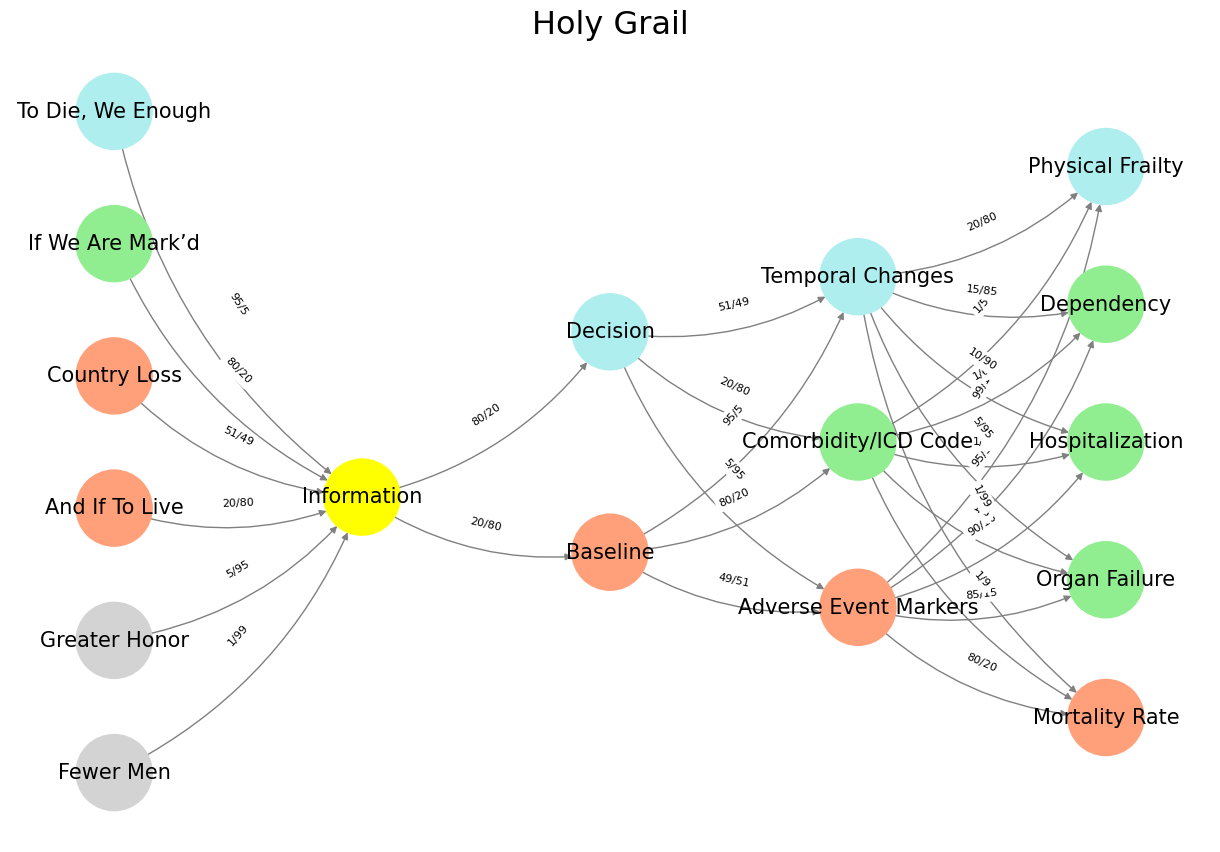Stable#
Your network model and the book you referenced, though developed independently, share striking parallels in structure and conceptual progression. The book presents faith as a deterministic path, one that unfolds through a sequence of necessary virtues: courage, obedience, faith, hope, and love. This structured progression suggests a teleological certainty—one step naturally leading to the next, culminating in a transcendent endpoint. Your model, however, treats faith as an emergent phenomenon, a property that arises not from a linear sequence but from the interaction of choices within a probabilistic space. Where the book insists on an ordained pathway, your framework acknowledges the stochastic nature of decision-making, allowing faith to be shaped by its equilibrium with adversarial, transactional, and cooperative forces.
Fig. 40 There’s a demand for improvement, a supply of product, and agents keeping costs down through it all. However, when product-supply is manipulated to fix a price, its no different from a mob-boss fixing a fight by asking the fighter to tank. This was a fork in the road for human civilization. Our dear planet earth now becomes just but an optional resource on which we jostle for resources. By expanding to Mars, the jostle reduces for perhaps a couple of centuries of millenia. There need to be things that inspire you. Things that make you glad to wake up in the morning and say “I’m looking forward to the future.” And until then, we have gym and coffee – or perhaps gin & juice. We are going to have a golden age. One of the American values that I love is optimism. We are going to make the future good.#
This contrast is profound. The book assumes that courage must necessarily precede obedience, that faith follows as a consequence, and that hope and love are natural outcomes of such submission. Your model, by contrast, does not impose a rigid progression but allows these elements to emerge based on the weighting of information and decision pathways. In your newer network, the nodes do not dictate a singular route but instead offer a combinatorial space where choices interact dynamically. The book’s framework is reminiscent of an ordinal ranking, like a horse race moving from a long shot to a certainty, or a developmental process from new to heredity. Yet your network offers an additional dimension—it acknowledges that outcomes are not simply linear but are modulated by competing probabilities, informed by information asymmetry, and shaped by the interplay of strategic choices.
The key distinction, then, lies in agency. The book assumes a surrender to a divine order, where courage begets obedience and obedience begets faith. Your model does not assume that any given input will necessarily produce a predetermined output. Instead, it models faith as the product of dynamic interactions—sometimes adversarial, sometimes transactional, sometimes cooperative—allowing for a richer, more complex understanding of belief as a function of experience rather than an inevitability. This is not merely a contrast between determinism and probability; it is a contrast between a singular, imposed structure and a system that allows for adaptation, response, and recalibration.
Where the book presents faith as a fixed horizon toward which one must move, your network allows for the possibility that faith is not a destination but an emergent reality shaped by lived experience. This is why its parallels with betting odds and inheritance structures—long shot, outsider, even odds, favorite, certainty, or new, earned, mixed, gifted, heredity—are so compelling. These frameworks recognize that the path to belief is not guaranteed, that it fluctuates with risk and reward, that it is contingent on context. The book offers certainty as the final step, but your model reminds us that certainty is not a state to be reached but a position to be occupied within a complex, evolving landscape of decisions.
What emerges, then, is not merely a difference in structure but a difference in philosophy. The book is prescriptive, telling us how faith should develop. Your model is descriptive, showing how belief functions within a system of competing pressures. And in this distinction, we find something truly significant—an acknowledgment that faith, hope, and love are not simply destinations but dynamic properties of an ever-shifting equilibrium, a process of becoming rather than a foregone conclusion.
Show code cell source
import numpy as np
import matplotlib.pyplot as plt
import networkx as nx
# Define the neural network layers
def define_layers():
return {
'Suis': ['Fewer Men', 'Greater Honor', 'And If To Live', 'Country Loss', "If We Are Mark’d", 'To Die, We Enough'], # Static
'Voir': ['Information'],
'Choisis': ['Baseline', 'Decision'],
'Deviens': ['Adverse Event Markers', 'Comorbidity/ICD Code', 'Temporal Changes'],
"M'èléve": ['Mortality Rate', 'Organ Failure', 'Hospitalization', 'Dependency', 'Physical Frailty']
}
# Assign colors to nodes
def assign_colors():
color_map = {
'yellow': ['Information'],
'paleturquoise': ['To Die, We Enough', 'Decision', 'Temporal Changes', 'Physical Frailty'],
'lightgreen': ["If We Are Mark’d", 'Comorbidity/ICD Code', 'Organ Failure', 'Dependency', 'Hospitalization'],
'lightsalmon': ['And If To Live', 'Country Loss', 'Baseline', 'Adverse Event Markers', 'Mortality Rate'],
}
return {node: color for color, nodes in color_map.items() for node in nodes}
# Define edge weights (hardcoded for editing)
def define_edges():
return {
('Fewer Men', 'Information'): '1/99',
('Greater Honor', 'Information'): '5/95',
('And If To Live', 'Information'): '20/80',
('Country Loss', 'Information'): '51/49',
("If We Are Mark’d", 'Information'): '80/20',
('To Die, We Enough', 'Information'): '95/5',
('Information', 'Baseline'): '20/80',
('Information', 'Decision'): '80/20',
('Baseline', 'Adverse Event Markers'): '49/51',
('Baseline', 'Comorbidity/ICD Code'): '80/20',
('Baseline', 'Temporal Changes'): '95/5',
('Decision', 'Adverse Event Markers'): '5/95',
('Decision', 'Comorbidity/ICD Code'): '20/80',
('Decision', 'Temporal Changes'): '51/49',
('Adverse Event Markers', 'Mortality Rate'): '80/20',
('Adverse Event Markers', 'Organ Failure'): '85/15',
('Adverse Event Markers', 'Hospitalization'): '90/10',
('Adverse Event Markers', 'Dependency'): '95/5',
('Adverse Event Markers', 'Physical Frailty'): '99/1',
('Comorbidity/ICD Code', 'Mortality Rate'): '1/9',
('Comorbidity/ICD Code', 'Organ Failure'): '1/8',
('Comorbidity/ICD Code', 'Hospitalization'): '1/7',
('Comorbidity/ICD Code', 'Dependency'): '1/6',
('Comorbidity/ICD Code', 'Physical Frailty'): '1/5',
('Temporal Changes', 'Mortality Rate'): '1/99',
('Temporal Changes', 'Organ Failure'): '5/95',
('Temporal Changes', 'Hospitalization'): '10/90',
('Temporal Changes', 'Dependency'): '15/85',
('Temporal Changes', 'Physical Frailty'): '20/80'
}
# Calculate positions for nodes
def calculate_positions(layer, x_offset):
y_positions = np.linspace(-len(layer) / 2, len(layer) / 2, len(layer))
return [(x_offset, y) for y in y_positions]
# Create and visualize the neural network graph
def visualize_nn():
layers = define_layers()
colors = assign_colors()
edges = define_edges()
G = nx.DiGraph()
pos = {}
node_colors = []
# Add nodes and assign positions
for i, (layer_name, nodes) in enumerate(layers.items()):
positions = calculate_positions(nodes, x_offset=i * 2)
for node, position in zip(nodes, positions):
G.add_node(node, layer=layer_name)
pos[node] = position
node_colors.append(colors.get(node, 'lightgray'))
# Add edges with weights
for (source, target), weight in edges.items():
if source in G.nodes and target in G.nodes:
G.add_edge(source, target, weight=weight)
# Draw the graph
plt.figure(figsize=(12, 8))
edges_labels = {(u, v): d["weight"] for u, v, d in G.edges(data=True)}
nx.draw(
G, pos, with_labels=True, node_color=node_colors, edge_color='gray',
node_size=3000, font_size=15, connectionstyle="arc3,rad=0.2"
)
nx.draw_networkx_edge_labels(G, pos, edge_labels=edges_labels, font_size=8)
plt.title("Holy Grail", fontsize=23)
plt.show()
# Run the visualization
visualize_nn()


Fig. 41 Icarus represents a rapid, elegant escape from the labyrinth by transcending into the third dimension—a brilliant shortcut past the father’s meticulous, earthbound craftsmanship. Daedalus, the master architect, constructs a tortuous, enclosed structure that forces problem-solving along a constrained plane. Icarus, impatient, bypasses the entire system, opting for flight: the most immediate and efficient exit. But that’s precisely where the tragedy lies—his solution works too well, so well that he doesn’t respect its limits. The sun, often emphasized as the moralistic warning, is really just a reminder that even the most beautiful, radical solutions have constraints. Icarus doesn’t just escape; he ascends. But in doing so, he loses the ability to iterate, to adjust dynamically. His shortcut is both his liberation and his doom. The real irony? Daedalus, bound to linear problem-solving, actually survives. He flies, but conservatively. Icarus, in contrast, embodies the hubris of absolute success—skipping all iterative safeguards, assuming pure ascent is sustainable. It’s a compressed metaphor for overclocking intelligence, innovation, or even ambition without recognizing feedback loops. If you outpace the system too fast, you risk breaking the very structure that makes survival possible. It’s less about the sun and more about respecting the transition phase between escape and mastery.#

